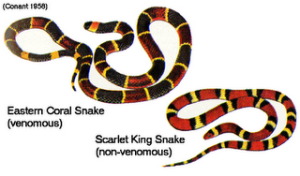By Carl Zimmer, The New York Times, August 20, 2015
The Canadian tiger swallowtail caterpillar is a plump green creature that spends all its time munching leaves. It ought to be an easy meal for a bird, yet many birds pass it by.
The caterpillar is protected by a remarkable defense, researchers have found: It tricks birds into thinking it’s a snake.
The caterpillar grows concentric yellow and black rings that look like a giant pair of eyes. When the caterpillar senses a bird nearby, it quickly inflates the front part of its body, making it resemble a snake’s head.
Astonishing as this deception may be, the tiger swallowtail is hardly unique. Many species have evolved ways to fool would-be predators. Some insects look like twigs, even mimicking the way that twigs sway in the breeze.
Harmless snakes scare off predators by mimicking the look of venomous ones. Some species of hoverflies have the yellow and black stripes of stinging wasps. They even pretend to sting their enemies despite having no stinger at all.
But mimicry has revealed a puzzle at its heart: Time and again, scientists find examples of overkill. Animals don’t seem to receive an extra benefit from making their disguises more elaborate.
The Canadian tiger swallowtail is an excellent example. Over the past few years, Thomas N. Sherratt, a behavioral ecologist at Carleton University in Ontario, and graduate student Thomas J. Hossie have studied the caterpillar’s strategy by creating “pastry caterpillars” of flour, water, shortening and green food coloring.
They are apparently tasty. When the scientists placed pastry caterpillars on tree branches, many of them quickly disappeared. “Birds are really motivated to eat them,” Dr. Sherratt said.
Dr. Hossie, who is now a postdoctoral researcher at Trent University in Ontario, created a batch of pastry caterpillars with eye spots and snakelike heads. A substantial number of these more elaborate models remained on the branches, presumably because they scared away many birds.
Surprisingly, though, pastry caterpillars don’t require a complicated disguise to deter birds. The scientists also created fake caterpillars with eyespots but no snakelike head. The birds avoided these simpler mimics about as often as they did the more elaborate ones.
If real caterpillars don’t gain extra protection from extra deception, the scientists wondered, then how could their disguise have evolved?
The researchers suspected that they had missed something in their experiments in the woods. For one thing, they had not actually watched birds as they ate or avoided the pastry caterpillars. They had simply counted up the pastries that remained on branches.
To take a closer look at the birds, the Canadian scientists teamed with John Skelhorn, who studies mimicry in his laboratory in Newcastle, England.
The scientists baked more batches of pastry caterpillars, but this time didn’t put them on tree branches. Instead, they presented the models to day-old chicks.
They picked such young animals to judge whether the birds are born with a fear of snakes and snakelike objects. “These chicks haven’t seen anything like a snake before,” Dr. Sherratt said.
When the chicks were presented with simple green cylinders, they happily pecked at them. But if the scientists added eyespots, the chicks became far more wary. Consistent with earlier research, the scientists found that adding a snakelike head didn’t make the chicks any more fearful.
But the experiment didn’t end there. Over the next two days, the scientists presented the chicks with pastry caterpillars five more times. By the end, the chicks had learned that cylinders with eye spots were in fact tasty snacks.
That was not the case when the chicks were presented with pastry caterpillars with both eye spots and snakelike heads. Even at the end of the study, the chicks were still fairly wary of the more realistic mimics.
The researchers published their results Aug. 14 in the journal Behavioral Ecology.
Dr. Skelhorn and his colleagues suspect that birds have evolved a healthy fear of snakes, present from the moment they hatch from their eggs. They don’t need to see a snake in full detail before deciding to flee. Just a few distinctive features — like snake eyes — may be enough. The caterpillars exploit that quick response to deter the birds.
But birds, like other animals, can learn to tell objects apart. This ability may have driven caterpillars to evolve more elaborate disguises, which are harder for birds to learn to distinguish from snakes.
“It takes more information for the birds to be convinced they’re not a snake,” Dr. Skelhorn said. The caterpillars “can fool predators for longer and survive.”
Olof Leimar, an evolutionary biologist at Stockholm University who was not involved in the study, said that it demonstrated how deceptive animals can exploit the wiring of their predators’ brains. “Without understanding the psychology, you can’t understand the phenomenon,” he said.
Dr. Sherratt hopes that their experiment will inspire other researchers to run similar studies on other mimics. He suspects that other “overevolved” deceivers may actually be exploiting how their enemies learn.
“Of course, you need to do it a few more times to see if it’s real,” he said.

No comments:
Post a Comment